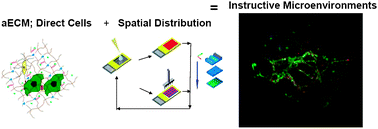Engineering 3D cell instructive microenvironments by rational assembly of artificial extracellular matrices and cell patterning†
Abstract
Engineered artificial microenvironments hold enormous potential as models to study developmental, physiological, pathological, and regenerative processes under highly defined conditions. Such platforms aim at bridging the gap between traditional in vitro 2D culture systems and animal models. By dissecting the biological complexity into an amenable number of parameters, systemic manipulation and study in controllable environments closely resembling the in vivo situation is possible. Novel strategies that address the evaluation of either ECM components, growth factors or cell–cell interactions on cellular behaviour are being developed. However, reliable methods that simultaneously recapitulate the natural instructive microenvironments in terms of cell and matrix composition, biological cues, heterogeneity and geometry are not yet available. Such spatially-defined microenvironments may be necessary to initiate and guide the formation of artificial tissues by morphogenetic processes. In this work, we introduce a flexible strategy that relies on the combination of artificial extracellular matrices with


 Please wait while we load your content...
Please wait while we load your content...